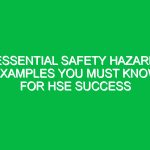Hello Team!
Today, we’re here for our Toolbox Talk, and I want to discuss an incredibly important topic: COVID-19 Worksite Safety. As we navigate our work Environment during these challenging times, it’s crucial that we all understand our roles in maintaining a safe workplace. COVID-19 has changed the way we operate, but by following specific guidelines and protocols, we can minimize the risk of infection while continuing our work effectively. Let’s dive into some essential tips and Best Practices that will promote Safety and wellbeing on our site.
The Importance of COVID-19 Worksite Safety
First and foremost, we need to recognize why COVID-19 Worksite Safety is vital. The health and safety of each team member is our top priority. Ensuring that everyone adheres to safety protocols can significantly reduce the transmission of the virus, protect our families, and allow us to continue our work without major disruptions. Remember, a safe workplace is not just a regulatory obligation but a commitment to each other as coworkers.
Understanding COVID-19 and Its Transmission
Before we discuss safety practices, let’s briefly talk about COVID-19 itself. COVID-19 is primarily spread through respiratory droplets when an infected person coughs, sneezes, or talks. It can also spread by touching surfaces contaminated with the virus and then touching your face. Understanding how the virus spreads is crucial in implementing effective safeguards.
Key Aspects of COVID-19 Worksite Safety
Now let’s go over the key aspects of COVID-19 Worksite Safety that we need to incorporate into our daily routines:
- Personal Protective Equipment (PPE): Wearing appropriate PPE, including masks and gloves, is vital. Ensure that your mask covers both your nose and mouth at all times.
- Social Distancing: Maintain at least six feet of distance between yourself and others whenever possible. This includes during breaks and meetings.
- Hand Hygiene: Wash your hands frequently with soap and water for at least 20 seconds, or use hand sanitizer when soap is unavailable.
- Surface Disinfection: Regularly clean and disinfect frequently touched surfaces, such as tools, equipment, and shared spaces.
- Health Monitoring: Conduct daily health checks before starting work. If you feel unwell or exhibit any COVID-19 symptoms, report it immediately and stay home.
Best Practices for Daily Operations
Let’s break down some Best Practices that can be easily integrated into our daily routines to ensure COVID-19 Worksite Safety:
- Pre-Shift Briefings: Conduct briefings outdoors or in well-ventilated areas to minimize close contact.
- Staggered Breaks: Implement staggered breaks to reduce the number of employees in break areas at one time.
- Tool Sharing: Limit the sharing of tools. If sharing is necessary, ensure tools are disinfected before and after use.
- Virtual Meetings: Whenever possible, opt for virtual meetings instead of in-person gatherings.
Real-Life Scenarios and Hypothetical Examples
Let’s consider a hypothetical scenario to illustrate the importance of these practices. Imagine one of our coworkers, Alex, starts feeling unwell with symptoms like a cough and fatigue. Instead of coming to work, Alex reports these symptoms and stays home. This decision not only protects Alex but also prevents the potential spread of the virus to the rest of the team. If you notice any symptoms in yourself or a coworker, it’s essential to act decisively.
Another example involves a situation where we have a scheduled meeting in a conference room. Instead of gathering in a small space, we decide to hold the meeting outside where there’s ample space for social distancing. This simple shift in location ensures that everyone remains safe while still collaborating effectively.
Open-Ended Questions for Engagement
To foster a culture of safety, I encourage you all to share your thoughts. Here are a few questions to consider:
- What challenges have you faced regarding COVID-19 Safety Measures on site?
- Can you think of additional ways we can improve our safety practices?
- Have you encountered any situations where someone didn’t follow safety protocols? How did you handle it?
Regulations and Compliance
It’s also crucial to understand that our COVID-19 Worksite Safety practices are not only recommended but often mandated by public health authorities and company policies. Familiarize yourself with local Regulations, as they may dictate specific Safety Measures we need to implement. Compliance with these regulations isn’t just about avoiding fines; it’s about creating a safe environment for everyone. Remember, failure to comply can result in serious consequences for both individuals and the organization.
The Role of Each Team Member
Every one of us has a role to play in ensuring that our workplace remains safe. This includes not only adhering to safety protocols but also holding each other accountable. If you see someone not following Safety Guidelines, approach them respectfully and remind them of the importance of these measures. We are all in this together, and by working as a team, we can create a safer workplace for everyone.
Conclusion
In summary, implementing effective COVID-19 Worksite Safety practices is essential for our health and well-being. By wearing masks, maintaining social distance, practicing good hand hygiene, and monitoring our health, we can significantly reduce the risk of infection. Remember, staying informed and proactive not only protects you but also your coworkers and loved ones.
Thank you all for your attention and commitment to maintaining a safe workplace. Let’s continue to support each other in these efforts and ensure that we all return home safely at the end of each day. If you have any questions or concerns, please feel free to share them now or reach out to me later. Stay safe, everyone!


